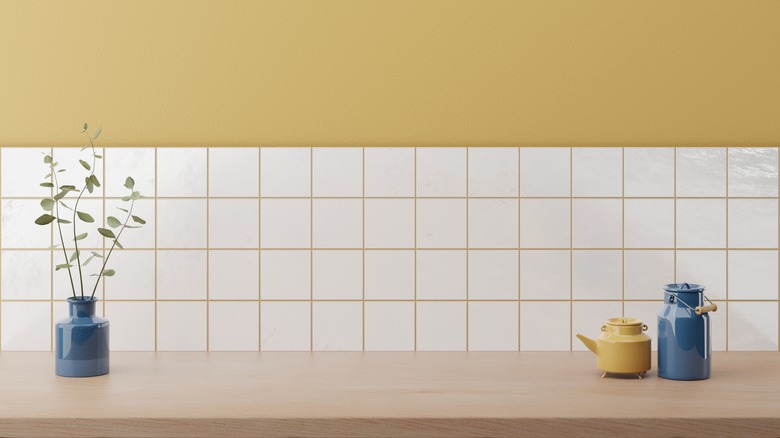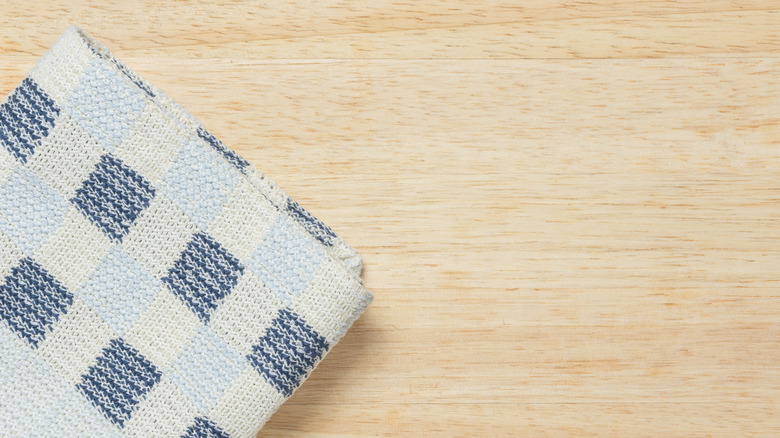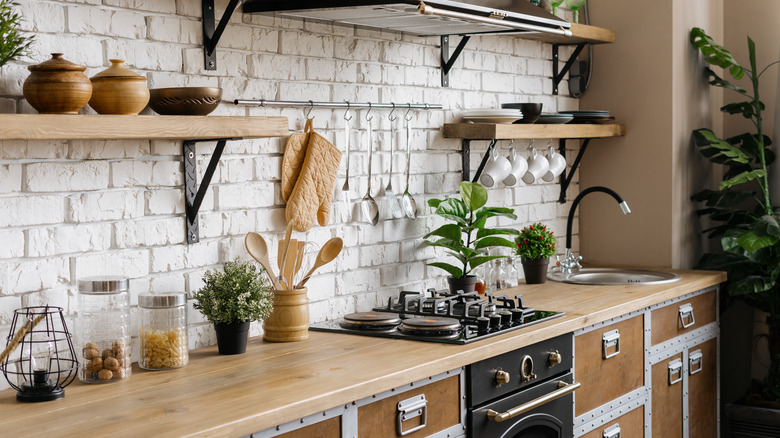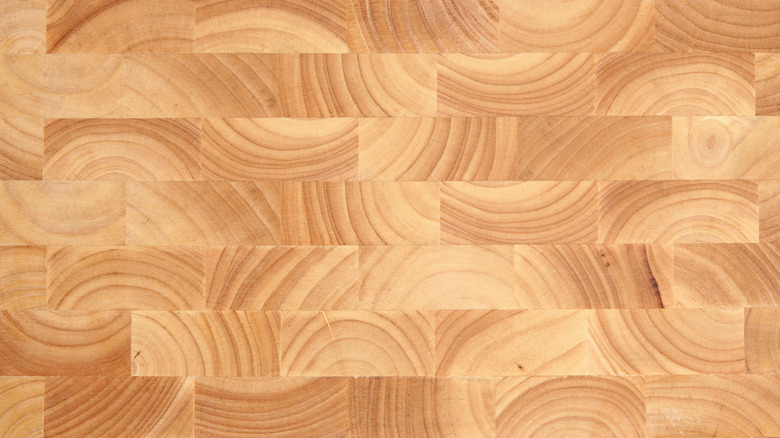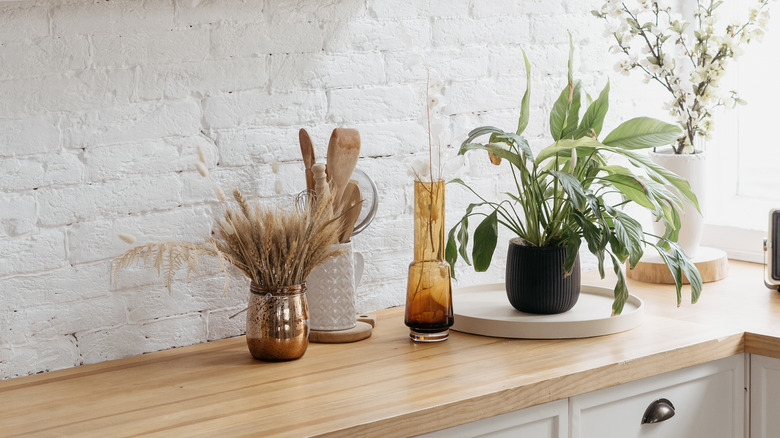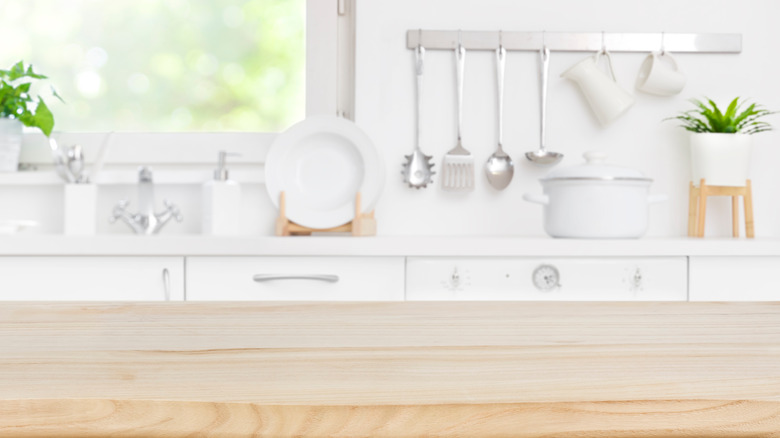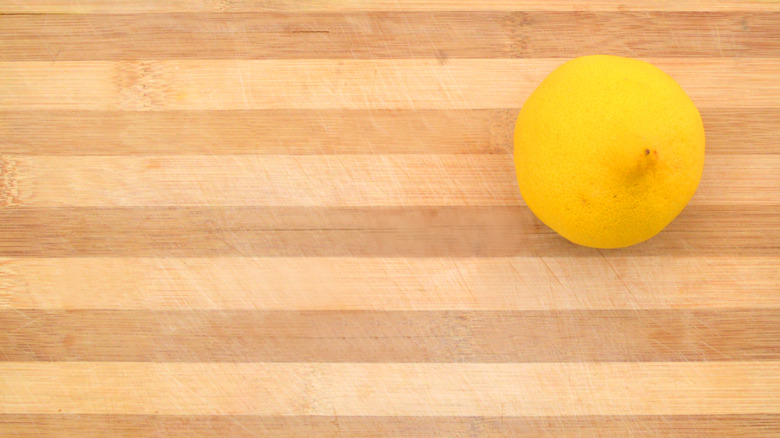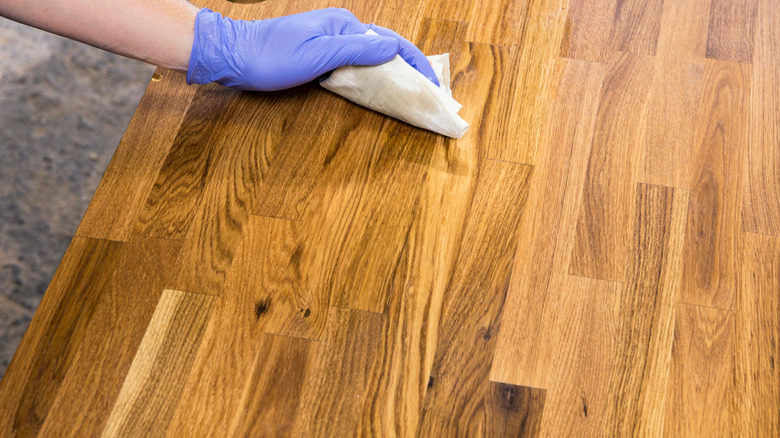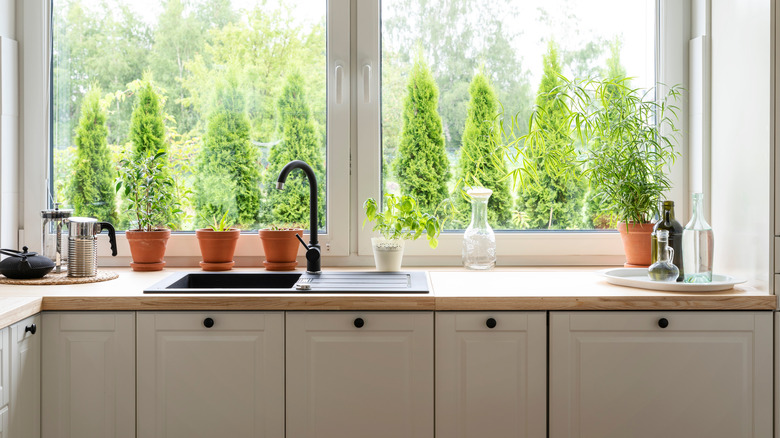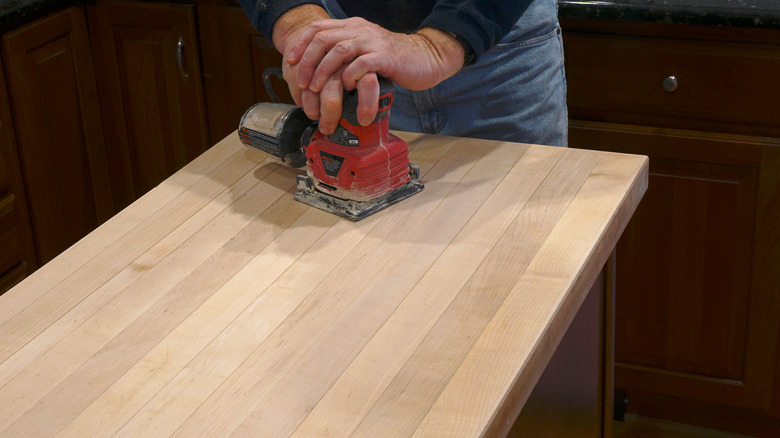How To Keep Butcher Block In Pristine Condition
Have you ever visited a kitchen with butcher block countertops in like-new condition and thought, "But how?" Keeping butcher block surfaces in pristine condition may be simpler than you think. You can keep butcher block clean, disinfected, and sealed using mostly natural ingredients including lemon or lemon juice, regular table salt, white vinegar, dish soap, baking soda, and food-grade mineral oil.
Simple tools include soft cotton, microfiber, or lint-free cloths, a sponge, scrubbing brush, plastic dough scraper, a spray bottle, and sandpaper. Keeping your butcher block in tip-top shape will likely require 5 minutes daily to clean and disinfect, and 15 minutes monthly to reseal it with oil and wax. Expect it to last 20 years – maybe longer if you completely resurface it every decade or so.
Some of the most common mistakes made with butcher block are allowing water stains, burn marks from hot pots, cracks, splinters, nicks, and dry spots to accumulate. Other hazards and concerns are bacteria growth and warping. Butcher block is typically made of end-grain or edge-grain maple, walnut, or oak wood pieces glued together. If you're making the investment in butcher block, follow these steps to ensure it lives up to its reputation as one of the hardest-working and most durable kitchen counter surfaces available.
Wipe up spills and excess moisture right away
The worst thing for your butcher block is to allow too much standing water to soak into the wood, so avoid excess water at all costs. If a spill does happen, clean it up quickly. Excess water can cause ring stains, splitting at the seams, warping, or mold growth. You'll need a sponge, towel, or cloth on hand at all times to wipe up spills as soon as they occur. Thankfully, if you're regularly applying mineral oil to your butcher block (see below), it will be resistant to low levels of moisture.
Keep an eye on endlessly wet areas like your sink, faucet, and dish drain, taking care to ensure you're keeping them dry. Make it part of your daily cleaning routine to get under any countertop appliance or accessory where moisture could collect, like a blender or a potted plant. If you have a butcher block cutting board, never let it soak in a sink full of water or put it in the dishwasher, or it could become damaged beyond repair.
Use trivets to avoid burning your butcher block
Second only to allowing too much water to soak into the wood, the worst thing you can do to your butcher block is to set a hot pan directly on it. It won't melt like other countertop surfaces will, but a hot pot or pan can blacken and discolor your wood with a permanent burn mark. Butcher block, like popular marble and quartz, is known to be "heat-resistant" but not heat-proof. This means it can withstand some heat, but it's better to be safe than sorry.
Purchase a few trivets and hot pads and have them on hand so you're never tempted to rest a pot or pan directly on your wood counter. If you do get a burn mark, use fine-grit sandpaper to sand off your butcher block surface. After sanding, reseal the surface with oil and wood conditioner (see below).
Avoid cutting your butcher block; use a dough scraper if needed
Butcher blocks offer a classic look that recalls a working kitchen of yesteryear or a neighborhood corner butcher shop, but if you want yours to last, take care not to recreate the scene. Today's butcher block counters are more for looks than the function of their namesake. In other words, avoid slicing or cutting directly on your butcher block. It's tempting to use it as a cutting board, but doing this not only scratches your wood, it can lead to bacteria buildup, even in microscopic cuts. This is especially true if you're cutting raw meat, which the Centers for Disease Control and Prevention advises should have its own dedicated cutting surface.
Some woods are softer than others, and therefore more likely to scratch, but all wood is more susceptible to cuts than a stone or ceramic counter. To keep yours in pristine condition, use a separate cutting board or a soft plastic flexible cutting board mat, which can be put in the dishwasher, when prepping food. Like burn marks, knife cuts and dings can be sanded out with fine-grit sandpaper, then resealed with oil and wood conditioner.
Speaking of sharp metal edges, if your butcher block has stuck-on food and you must scrape it off, use a plastic dough scraper. It will be more gentle on your butcher block surface than a metal scraper. In fact, we recommend scraping food with a plastic dough scraper as your first step in daily cleaning.
Clean daily with water and dish soap
This is when it's ok to apply a little bit of water to your butcher block. Step two of a good daily routine is cleaning your butcher block with water, dish soap, and a sponge. A regular sponge is soft enough for daily use and won't scratch your butcher block. Start by wiping off any crumbs with your dough scraper.
Once your butcher block is free of food particles, fill a container or small bowl with about two cups of warm or hot water and a few squirts of liquid dish soap. Alternatively, add a squirt of dish soap directly to a wet sponge. Squeeze to wring out your sponge so it's not too wet and scrub along the wood grain.
After your butcher block is scrubbed and soapy, rinse out your sponge until the water runs clear. Wipe your butcher block again with the clean, wet sponge, taking care to remove all soapy residue and also to absorb any excess water. You may need to rinse out your sponge several times. Dry with a clean, dry dishtowel or blot with paper towels.
Disinfect daily and remove odors
Step three of your daily routine should be disinfecting your butcher block to keep it in pristine condition. Wood is natural, as are its best cleaning agents. Avoid using harsh chemicals and bleach on wood because they could discolor it. Distilled white vinegar diluted with an equal amount of water in a spray bottle should do the trick. Spray over your clean butcher block, wipe with a soft cloth or dishtowel, and let it air dry.
Air drying typically naturally takes 10 or 15 minutes. If you don't have a spray bottle, simply blot some diluted vinegar directly on a cloth or towel, then give your butcher block a vinegar wipe-down. Vinegar is five percent acetic acid, per NSF, so it's already a gentle disinfectant; but we recommend diluting it because full-strength vinegar could be enough to dissolve the adhesive that keeps wood pieces glued together on butcher blocks.
Some people don't like the smell of vinegar, in which case there's another natural option that is gentle on wood: salt and lemon juice. Create a paste out of a half-cup of salt and a cup of lemon juice in a bowl. Apply with a cloth or sponge to your butcher block, then wipe away with a clean cloth. Or cut a lemon in half, sprinkle salt on your butcher block, and scrub. Lemon naturally disinfects and removes odors from wood surfaces. You can use this method for spot-cleaning your butcher block, too.
Use lemon, baking soda, or sandpaper to remove tough stains
Unfortunately wood shows stains quickly and easily. Use salt-and-lemon if your butcher block becomes stained by a red wine spill, fruit juices, or even a burn. Regular table salt acts as an abrasive and lemon juice is a natural antibacterial cleaner, bleaching agent, and deodorizer. As mentioned, you can make a paste and apply it to your butcher block with a cloth, or you can sprinkle salt directly on the stain and either squeeze lemon juice over it and rub with a stiff scrubbing brush, or rub the salt with a lemon sliced in half. For really tough stains, apply your salt-and-lemon paste, cover with plastic wrap, let sit for 15 minutes, and then scrub some more. Let the salt-lemon mix dry overnight, wipe off the dried salt, and rinse with warm water. Pat dry with paper towels or a clean dish towel. Repeat as needed.
You can also use baking soda or fine 220-grit sandpaper to tackle stains on your butcher block. Mix baking soda with water to make a paste, apply with a stiff scrubbing brush, rinse with warm water, and pat dry with paper towels or a clean dish towel. If using sandpaper, simply sand the stain, then wipe the dust away or vacuum it. Be careful not to sand too much in one spot (otherwise you could end up with an uneven surface), and do your best to follow the wood grain while sanding.
After removing stains, let your butcher block dry overnight, then reseal with oil and conditioner.
Reseal your butcher block monthly with mineral oil
The next two steps are protective actions to take monthly or as needed when your butcher block appears dry. Before you do these, follow all the steps above so you're starting with a clean, dry butcher block surface, ideally one that has dried overnight. Keeping your butcher block sealed with mineral oil is important because it not only prevents wood from getting too dry and cracking or splintering, but it also helps keep unwanted moisture out. So, in the case that you spill or splash water (like in the area around your sink), your sealed wood will be more resilient against water damage and stains, not to mention nicks and cuts.
Since oil soaks into wood, you may need to apply more than one coat. Dry climates and dry times of year can require more frequent oil applications. If it seems confusing, don't worry — after a few months you'll learn to recognize what your butcher block looks and feels like when the wood is clean, supple, oiled, and properly moisturized.
To reseal, or oil, your butcher block, simply pour some food-grade mineral oil or walnut oil onto your butcher block and work it into the wood with a lint-free or cotton cloth. It should soak in almost immediately. Don't let oil pool, and instead work it in as the wood soaks it up. Let it air dry and return 20 minutes to 30 minutes to repeat if necessary. You'll know you've reached your wood's limit when the oil stays on the surface and doesn't soak in. In most cases, two coats are enough. Buff the entire surface with a clean cloth and wipe away any remaining oil. Do not use oil from your pantry such as olive oil or canola oil.
Condition your butcher block with a beeswax wood conditioner
After applying mineral oil, apply a food-grade conditioner. Conditioner is typically a mix of mineral oil and beeswax and will help your surface smell nice, take on more shine, and smooth out micro-abrasions and cuts. It will help lock the initial coat of mineral oil in and act as another barrier to unwanted moisture. Conditioner is not as necessary or crucial as applying mineral oil, but it will extend the life of your butcher block by adding an extra layer of water resistance. When a butcher block surface is properly conditioned with oil and beeswax, water will bead on the surface.
Apply conditioner the same way you apply oil: spread it over your dry butcher block surface with a soft cotton or lint-free cloth, let it soak in, and buff with another clean cloth. Wax comes in a more solid form than oil, but softens as you apply it. According to Howard Products, conditioner can soak in for as little as 20 minutes or as long as overnight for a large countertop. The longer you use conditioner, the less often you will need to apply it. Store used cloths in a plastic baggie.
Completely resurface your butcher block every 10 years
Over time, butcher blocks can develop discoloration, odors, wear and tear, and dullness, even with regular cleaning. For a refresh, a light sanding will do — don't take too much off the top.
Remove everything from your butcher block countertop. Start by cleaning and disinfecting your butcher block. This Old House recommends sanding twice all over with a six-inch random-orbit sander, first using 100-grit, then using 150-grit sandpaper. Wipe the dust away or vacuum it off. Follow by applying oil and conditioner. Your butcher block will feel and look smooth and ready for ten more years of work.
Wood is a dynamic material that looks and performs in amazing ways when well cared for. Connecting with its natural properties is a meditative, zen-like process. Following these steps regularly can help you appreciate your butcher block's surface for its natural beauty for years to come.
